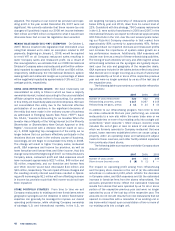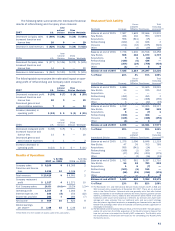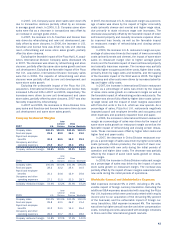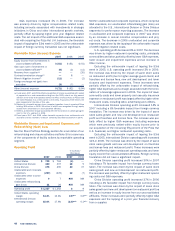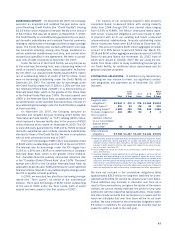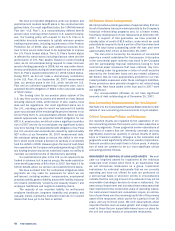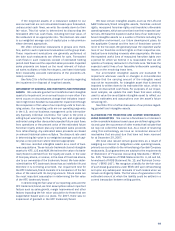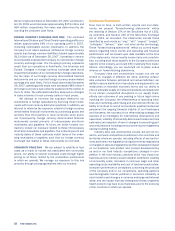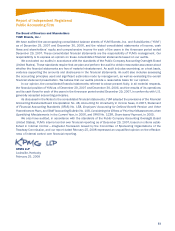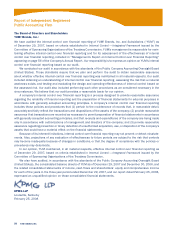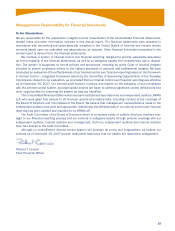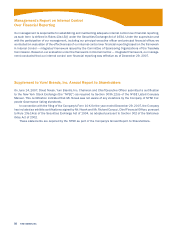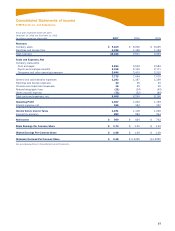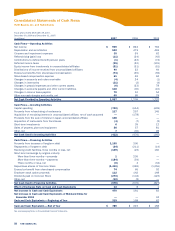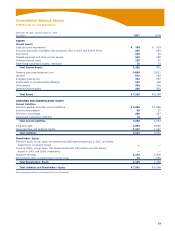Pizza Hut 2007 Annual Report Download - page 45
Download and view the complete annual report
Please find page 45 of the 2007 Pizza Hut annual report below. You can navigate through the pages in the report by either clicking on the pages listed below, or by using the keyword search tool below to find specific information within the annual report.49
If the long-lived assets of a restaurant subject to our
semi-annual test are not recoverable based upon forecasted,
undiscounted cash flows, we write the assets down to their
fair value. This fair value is determined by discounting the
forecasted after tax cash flows, including terminal value, of
the restaurant at an appropriate rate. The discount rate used
is our weighted average cost of capital plus a risk premium
where deemed appropriate.
We often refranchise restaurants in groups and, there-
fore, perform such impairment evaluations at the group level.
These impairment evaluations are generally performed at
the date such restaurants are offered for sale. Forecasted
cash flows in such instances consist of estimated holding
period cash flows and the expected sales proceeds. Expected
sales proceeds are based on the most relevant of histori-
cal sales multiples or bids from buyers, and have historically
been reasonably accurate estimations of the proceeds ulti-
mately received.
See Note 2 for a further discussion of our policy regarding
the impairment or disposal of long-lived assets.
IMPAIRMENT OF GOODWILL AND INDEFINITE-LIVED INTANGIBLE
ASSETS We evaluate goodwill and indefinite-lived intangible
assets for impairment on an annual basis or more often if an
event occurs or circumstances change that indicates impair-
ment might exist. Goodwill is evaluated for impairment through
the comparison of fair value of our reporting units to their car-
rying values. Our reporting units are our operating segments
in the U.S. and our business management units internation-
ally (typically individual countries). Fair value is the price a
willing buyer would pay for the reporting unit, and is generally
estimated using either discounted expected future cash flows
from operations or the present value of the estimated future
franchise royalty stream plus any estimated sales proceeds
from refranchising. Any estimated sales proceeds are based
on relevant historical sales multiples. The discount rate used
in determining fair value is our weighted average cost of capi-
tal plus a risk premium where deemed appropriate.
We have recorded intangible assets as a result of busi-
ness acquisitions. These include trademark/brand intangible
assets for KFC, LJS and A&W. We believe the value of a trade-
mark/brand is derived from the royalty we avoid, in the case
of Company stores, or receive, in the case of franchise stores,
due to our ownership of the trademark/brand. We have deter-
mined that the KFC trademark/brand has an indefinite life and
therefore it is not being amortized. Our impairment test for
the KFC trademark/brand consists of a comparison of the fair
value of the asset with its carrying amount. Future sales are
the most important assumption in determining the fair value
of the KFC trademark/brand.
In determining the fair value of our reporting units and the
KFC trademark/brand, we limit assumptions about important
factors such as sales growth, margin improvement and other
factors impacting the fair value calculation to those that are
supportable based upon our plans. For 2007, there was no
impairment of goodwill or the KFC trademark/brand.
We have certain intangible assets, such as the LJS and
A&W trademark/brand intangible assets, franchise contract
rights, reacquired franchise rights and favorable/unfavorable
operating leases, which are amortized over their expected use-
ful lives. We base the expected useful lives of our trademark/
brand intangible assets on a number of factors including the
competitive environment, our future development plans for
the applicable Concept and the level of franchisee commit-
ment to the Concept. We generally base the expected useful
lives of our franchise contract rights on their respective con-
tractual terms including renewals when appropriate. We base
the expected useful lives of reacquired franchise rights over
a period for which we believe it is reasonable that we will
operate a Company restaurant in the trade area. We base the
expected useful lives of our favorable/unfavorable operating
leases on the remaining lease term.
Our amortizable intangible assets are evaluated for
impairment whenever events or changes in circumstances
indicate that the carrying amount of the intangible asset
may not be recoverable. An intangible asset that is deemed
impaired is written down to its estimated fair value, which is
based on discounted cash flows. For purposes of our impair-
ment analysis, we update the cash flows that were initially
used to value the amortizable intangible asset to reflect our
current estimates and assumptions over the asset’s future
remaining life.
See Note 2 for a further discussion of our policies regard-
ing goodwill and intangible assets.
ALLOWANCES FOR FRANCHISE AND LICENSE RECEIVABLES/
LEASE GUARANTEES We reserve a franchisee’s or licensee’s
entire receivable balance based upon pre-defined aging crite-
ria and upon the occurrence of other events that indicate that
we may not collect the balance due. As a result of reserving
using this methodology, we have an immaterial amount of
receivables that are past due that have not been reserved
for at December 29, 2007.
We have also issued certain guarantees as a result of
assigning our interest in obligations under operating leases,
primarily as a condition to the refranchising of certain Company
restaurants. Such guarantees are subject to the requirements
of Statement of Financial Accounting Standards (“SFAS”)
No. 145, “Rescission of FASB Statements No. 4, 44 and 64,
Amendment of FASB Statement No. 13, and Technical Correc-
tions” (“SFAS 145”). We recognize a liability for the fair value
of such lease guarantees under SFAS 145 upon refranchising
and upon any subsequent renewals of such leases when we
remain contingently liable. The fair value of a guarantee is the
estimated amount at which the liability could be settled in a
current transaction between willing parties.



